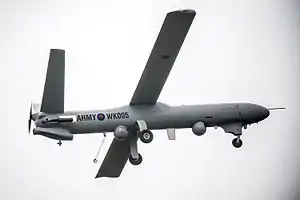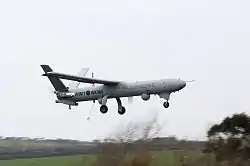Thales Watchkeeper WK450
The Thales Watchkeeper WK450 is an unmanned aerial vehicle (UAV) for all weather, intelligence, surveillance, target acquisition, and reconnaissance (ISTAR) use by the British Army. It is provided under an £800 million contract with UAS Tactical Systems (U-TacS), a joint venture of Elbit and Thales UK, and is based on Elbit's Hermes 450.[2]
| Watchkeeper WK450 | |
|---|---|
 | |
| Flight trials at Parc Aberporth in 2013 | |
| Role | Unmanned aerial vehicle |
| National origin | United Kingdom |
| Manufacturer | Thales Group & Elbit Systems |
| First flight | 14 April 2010 |
| Introduction | 30 November 2018 (full operational capability) |
| Status | In service[1] |
| Primary user | British Army |
| Developed from | Elbit Hermes 450 |
Overview
The Watchkeeper WK450 is based on the Elbit Hermes 450 UAV and is built in the UK by a joint venture company, UAV Tactical Systems (U-TacS), set up by the Israeli company Elbit Systems (51% ownership) and the Thales group. The Watchkeeper is 6.5m long, with a 10.9m wingspan. Its cruising speed is 77 knots (143 km/h), and it can operate at an altitude of 16,000 feet (4,900 m). It has a takeoff weight of 485 kg, a typical endurance of 14 hours,[3] a payload capacity of 150 kg and uses a rotary Wankel engine provided by UAV Engines Ltd, a wholly owned subsidiary of Elbit Systems.[4] It can operate up to 150 km from the Ground Control Station; multiple stations can be linked to extend the range.[5] It was originally intended to enter service in June 2010,[6] but years of delays, technical issues, hardware modifications, difficulties in training sufficient pilots and incidents means that it was not expected to be fully operational until late 2018.

A prime difference between the Hermes 450 and Watchkeeper is that the 450 is fitted only with an electro-optical/infrared sensor, while the WK450 has in addition a dual-mode synthetic aperture radar and ground moving target indication system that allows it to see through all weather conditions.[7] The British Army was to receive 30 Watchkeepers and a further 24 due to go into store to be deployed as needed.[8]
As of March 2018 the 47th Regiment Royal Artillery was the only unit operating the Watchkeeper.[9]
As of August 2020 Watchkeeper had accumulated over 3,000 flying hours since the first flight in 2010.[3]
History
On 15 July 2007, the UK MoD revealed that 54 Watchkeepers will be delivered to the British Army. The average cost to the taxpayer is therefore £800m divided by 54 aircraft, approximately £15m per platform.[10] However, this figure includes construction of new basing facilities at Boscombe Down airfield, ground training facilities and simulators at the School of Artillery, ground control stations, development and testing of extensive aircraft modifications including automatic take-off and landing and the integration and provision of new sensors including radars.
Watchkeeper's first UK flight took place on Wednesday 14 April 2010 from ParcAberporth in Wales,[11] but due to numerous delays the delivery date slipped.[12][13] By 2014 Watchkeeper had gained certification from the Military Aviation Authority, had its Release to Service granted was cleared for military flight training with the Royal Artillery, operating out of Boscombe Down in Wiltshire.[14] In February 2014 the French Ministry of Defence indicated that the French Army might purchase the Watchkeeper WK450,[15] but they instead selected the Sagem Patroller for the tactical unmanned air vehicle requirement.[16]
By December 2015 delivery to the British Army was progressing well, but there were difficulties in training sufficient pilots. As poor weather in Britain was limiting the time available to conduct flying training the decision was made to conduct future training on the tropical Ascension Island located in the Atlantic Ocean. Although there is hope that future modifications to the aircraft will enable it to fly in poor weather, the training on Ascension Island is set to continue for the foreseeable future. Enough pilots and ground crew are expected to be trained for full operational capability to be reached by early 2018.[17][18]
Costs of the programme to March 2018 were £1.08 billion, more than £200 million above the original budget. The original order was for 54 Watchkeepers, though it has not been confirmed that more than 45 had been delivered at that date.[2]
Watchkeeper achieved the Army's full operational capability 2 (FOC 2) milestone on 30 November 2018, though without formal release to service (RTS) certification, which would allow the trials facility to move from West Wales Airport, which has a nearby oversea trials area, to Boscombe Down.[1]
Incidents
During the development of Watchkeeper, some units crashed in the UK, and inquiries were held.
Two Watchkeepers crashed on flight trials over Cardigan Bay in February and March 2017, resulting in the grounding of all Watchkeepers for four months.[19][20] In June 2018 a Watchkeeper crashed on land near the trials base at West Wales Airport, increasing the number of Watchkeepers lost in crashes to five.[21][22]
As of December 2020 units that had crashed in the UK were WK031 - 16 October 2014, WK006 - 2 November 2015, WK042 - 3 February 2017, WK043 - 24 March 2017, and WK050 - 13 June 2018. Links to the enquiries are available at the Army Watchkeeper Web page.[3]
A Watchkeeper crashed in Cyprus in October 2020 during a practice.[23]
Deployment
On 29 September 2014, the MoD revealed that an undisclosed number of Watchkeepers had become fully operational and sent to Afghanistan. The aircraft were stationed at Camp Bastion to provide force protection for British troops and worked alongside Hermes 450s that it is derived from.[24] Watchkeeper proved its use by successfully supporting a detachment of U.S. Marines using its Thales I-Master radar. It cued a Hermes 450 onto a target for continued tracking, which then passed the information on to a Royal Air Force MQ-9 Reaper to conduct an airstrike. Some 140 flights were conducted for 8 hours a day until operations ceased in mid-October 2014.
Border patrol
In September 2020 under Operation Devran the UK Border Force started using Watchkeeper to patrol the English Channel for potential illegal entrants into the UK. But the operation was criticised as being of little practical value. Just 15 sorties, totalling 43 hours and 52 minutes, were flown in September 2020, and six sorties for 23 hours and 54 minutes were flown the following month. Chris Cole, director of Drone Wars UK, said "the use of military-grade drones at borders is the beginning of the use of drones that blur the boundaries between military and domestic policing".[23]
References
- Ripley, Tim (7 February 2019). "Watchkeeper achieves full operational capability". Jane's Defence Weekly. IHS. Archived from the original on 26 April 2019. Retrieved 18 April 2019.
- Corfield, Gareth (29 November 2017). "Watchkeeper drones cost taxpayers £1bn". The Register. Retrieved 18 April 2019.
- "Watchkeeper". army.mod.uk. 28 August 2020.
- Major Subsidiaries. Elbit Systems. Retrieved 3 January 2009.
- Army moves Watchkeeper drone training to tropics for winter after flying problems in UK weather - Thebureauinvestigates.com, 11 December 2015
- Lewis Page (2 March 2011). "Blighty's expensive Watchkeeper spy-drone in further delays". The Register. Retrieved 5 March 2011.
- British Army praises performance of Watchkeeper during debut deployment - Flightglobal.com, 17 November 2014
- http://www.defensenews.com/article/20140618/DEFREG01/306180015/UK-s-Watchkeeper-Fleet-Completed-by-End-Year?odyssey=nav%7Chead
- Ripley, Tim (21 March 2018). "UK Watchkeeper fails to achieve full operating capability milestone". Jane's Information Group. Archived from the original on 3 April 2018.
British Army sources said its sole Watchkeeper unit, 47 Regiment Royal Artillery based at Larkhill on Salisbury Plain, “continues to train and carry out exercises with Watchkeeper”.
- Lewis Page (15 June 2007). "UK MoD reveals Watchkeeper spy-drone numbers". The Register. Retrieved 3 January 2009.
- WATCHKEEPER makes first UK flight. Thales. Archived from the original on 18 April 2010. Retrieved 15 April 2010.
- "The UK's Watchkeeper ISTAR UAV". Retrieved 30 October 2010.
- Michael A. Taverna (28 February 2011). "Watchkeeper Gets New Delivery Date". Aviation Week. Retrieved 5 March 2011.
- "Newest eye in the sky Watchkeeper cleared to fly". Retrieved 5 March 2014.
- France negotiates acquisition of Watchkeeper drones against purchase of VBCI armoured by UK - Armyrecognition.com, 20 February 2014
- DGA defends Patroller buy, discloses Reaper aspirations - Flightglobal.com, 11 February 2016
- https://www.theyworkforyou.com/wrans/?id=2015-11-27.18062.h&s=%22watchkeeper%22#g18062.q0
- https://www.theyworkforyou.com/wrans/?id=2015-12-14.19865.h&s=%22watchkeeper%22
- Corfield, Gareth (1 November 2017). "Two drones, two crashes in two months: MoD still won't say why". The Register. Retrieved 18 April 2019.
- Corfield, Gareth (15 April 2019). "Brit Watchkeeper drone fell in the sea because blocked sensor made algorithms flip out". The Register. Retrieved 18 April 2019.
- Corfield, Gareth (14 June 2018). "... Aaaand that's a fifth Brit Army Watchkeeper drone to crash in Wales". The Register. Retrieved 18 April 2019.
- "MoD drone crashed into tree near Aberporth, report reveals". BBC News. 11 August 2019. Retrieved 17 August 2019.
- Doward, Jamie (26 December 2020). "British military Watchkeeper drone crashes during Cyprus training flight". The Guardian.
- Watchkeeper fully operational in Afghanistan, UK reveals - Flightglobal.com, 29 September 2014
External links
| Wikimedia Commons has media related to Thales Watchkeeper WK450. |
- Official website
- Announcement of contract in the House of Commons, Hansard column 86WS, 20 Jul 2005
- UK Gives $1.23B Green Light to Watchkeeper UAV, Defense Industry Daily, 25 July 2005
- Watchkeeper bidders, Spyflight